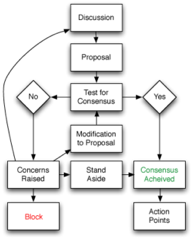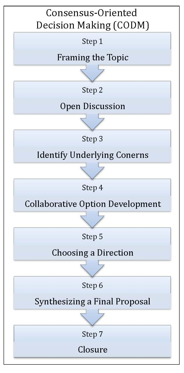The Basics of Consensus Decision Making
By Tim Hartnett, PhD
http://www.consensusbook.com
The Principles of Consensus Decision Making
Consensus is defined by Merriam-Webster’s Dictionary as “general agreement” or “the judgment arrived at by most of those concerned.”
Consensus decision making is a process used by groups seeking to generate widespread levels of participation and agreement. There are variations among different groups regarding the degree of agreement necessary to finalize a group decision. The process of group deliberation, however, has many common elements that are definitive of consensus decision making. These include:
-
Inclusive: As many stakeholders as possible are involved in group discussions.
-
Participatory: All participants are allowed a chance to contribute to the discussion.
-
Collaborative: The group constructs proposals with input from all interested group members. Any individual authorship of a proposal is subsumed as the group modifies it to include the concerns of all group members.
-
Agreement Seeking: The goal is to generate as much agreement as possible. Regardless of how much agreement is required to finalize a decision, a group using a consensus process makes a concerted attempt to reach full agreement.
-
Cooperative: Participants are encouraged to keep the good of the whole group in mind. Each individual’s preferences should be voiced so that the group can incorporate all concerns into an emerging proposal. Individual preferences should not, however, obstructively impede the progress of the group.
An Alternative to Common Decision Making Practices
Consensus decision making is an alternative to commonly practiced non-collaborative decision making processes. Robert’s Rule of Order, for instance, is a process used by many organizations. The goal of Robert’s Rules is to structure the debate and passage of proposals that win approval through majority vote. This process does not emphasize the goal of full agreement. Nor does it foster whole group collaboration and the inclusion of minority concerns in resulting proposals. Critics of Robert’s Rules believe that the process can involve adversarial debate and the formation of competing factions. These dynamics may harm group member relationships and undermine the ability of a group to cooperatively implement a contentious decision.
Consensus decision making is also an alternative to “top-down” decision making, commonly practiced in hierarchical groups. Top-down decision making occurs when leaders of a group make decisions in a way does not include the participation of all interested stakeholders. The leaders may (or may not) gather input, but they do not open the deliberation process to the whole group. Proposals are not collaboratively developed, and full agreement is not a primary objective. Critics of top-down decision making believe the process fosters incidence of either complacency or rebellion among disempowered group members. Additionally, the resulting decisions may overlook important concerns of those directly affected. Poor group relationship dynamics and decision implementation problems may result.
Consensus decision making addresses the problems of both Robert’s Rules of Order and top-down models. The goals of the consensus process include:
-
Better Decisions: Through including the input of all stakeholders the resulting proposals can best address all potential concerns.
-
Better Implementation: A process that includes and respects all parties, and generates as much agreement as possible sets the stage for greater cooperation in implementing the resulting decisions.
-
Better Group Relationships: A cooperative, collaborative group atmosphere fosters greater group cohesion and interpersonal connection.

The Process of Consensus Decision Making
There are multiple stepwise models of how to make decisions by consensus. They vary in the amount of detail the steps describe. They also vary depending on how decisions are finalized. The basic model involves collaboratively generating a proposal, identifying unsatisfied concerns, and then modifying the proposal to generate as much agreement as possible.
Finalizing a Decision
The level of agreement necessary to finalize a decision is known as a decision rule. The range of possible decision rules varies within the following range:
-
Unanimous agreement
-
Unanimity minus one vote
-
Unanimity minus two votes
-
Super majority thresholds (90%, 80%,
75%, two-thirds, and 60% are common).
-
Simple majority
-
Executive committee decides
-
Person-in-charge decides
Some groups require unanimous consent (unanimity)to approve group decisions. If any participant objects, he can block consensus according to the guidelines described below. These groups use the term consensus to denote both the discussion process and the decision rule. Other groups use a consensus process to generate as much agreement as possible, but allow decisions to be finalized with a decision rule that does not require unanimity.
Consensus Blocking
Groups that require unanimity allow individual participants the option of blocking a group decision. This provision motivates a group to make sure that all group members consent to any new proposal before it is adopted. Proper guidelines for the use of this option, however, are important. The ethics of consensus decision making encourage participants to place the good of the whole group above their own individual preferences. When there is potential for a group decision to be blocked, both the group and any dissenters in the group are encouraged to collaborate until agreement can be reached. Simply vetoing a decision is not considered a responsible use of consensus blocking. Some common guidelines for the use of consensus blocking include:
-
Limiting the option to block consensus to issues that are fundamental to the group’s mission or potentially disastrous to the group.
-
Providing an option for those who do not support a proposal to “stand aside” rather than block.
-
Requiring two or more people to block for a proposal to be put aside.
-
Require the blocking party to supply an alternative proposal or a process for generating one.
-
 Limiting each person’s option to block consensus to a handful of times in one’s life.
Limiting each person’s option to block consensus to a handful of times in one’s life.
A basic outline of consensus decision making that allows consensus blocking is outlined in this flow chart.
Agreement vs. Consent
Unanimity is achieved when the full group consents to a decision. Giving consent does not necessarily mean that the proposal being considered is one’s first choice. Group members can vote their consent to a proposal because they choose to cooperate with the direction of the group, rather than insist on their personal preference. Sometimes the vote on a proposal is framed, “Is this proposal something you can live with?” This relaxed threshold for a yes vote can help make unanimity more easily achievable. Alternatively, a group member can choose to stand aside. Standing aside communicates that while a participant does not necessarily support a group decision, he does not wish to block it.
Debate Over Decision Rules
Critics of consensus blocking object to empowering individuals to block otherwise popular proposals. They believe this can result in a group experience of widespread disagreement, the opposite of a consensus process’s primary goal. Further, they believe group decision making may become stagnated by the high threshold of unanimity. Important decisions may take too long to make, or the status quo may become virtually impossible to change. The resulting tension may undermine group functionality and harm relationships between group members.
Defenders of consensus blocking believe that decision rules short of unanimity do not ensure a rigorous search for full agreement before finalizing decisions. They value the commitment to reaching unanimity and the full collaborative effort this goal requires. They believe that under the right conditions unanimous consent is achievable and the process of getting there strengthens group relationships.
Conditions that Favor Unanimity
The goals of requiring unanimity are only fully realized when a group is successful in reaching it. Thus, it is important to consider what conditions make full agreement more likely. Here are some of the most important factors that improve the chances of successfully reaching unanimity:
-
Small group size
-
Clear common purpose
-
High levels of trust
-
Participants well trained in consensus process
-
Participants willing to put the best interest of the group before their own
-
Participants willing to spend sufficient time in meetings
-
Skillful facilitation and agenda preparation
Using Other Decisions Rules with a Consensus Process
Many groups use a consensus decision making process with non-unanimous decision rules. The consensus process can help prevent problems associated with Robert’s Rules of Order or top-down decision making. This allows majority rule or hierarchical organizations to benefit from the collaborative efforts of the whole group and the resulting joint ownership of final proposals. For instance, a small business owner may convene a consensus decision making discussion among her staff to generate a proposal for changes to the business. After the proposal is developed, however, the business owner may retain the authority to accept or reject it.
The benefits of consensus decision making are lost, however, if the final decision is made without regard to the efforts of the whole group. When group leaders or majority factions reject proposals that have been developed with widespread agreement of a group, the goals of consensus decision making will not be realized.
 More Elaborate Models of Consensus Decision Making
More Elaborate Models of Consensus Decision Making
As the field of group facilitation has evolved, more detailed models of consensus decision making have been developed. One example is the CODM model (consensus-oriented decision making). Newer models focus on the process of group collaboration, increasing understanding within the field of how collaboration can be best fostered and what facilitation techniques can promote it.
Origins of Consensus Decision Making
Historical examples of consensus decision making include the Iroquois Confederacy Grand Council, or Haudenosaunee, who finalized decisions with a 75% majority. Modern usage is often traced to the Quakers, or Religious Society of Friends, who practice unanimity. Activists groups, intentional communities, collective businesses have all developed and refined the process. Professional group facilitators now use the process in a large variety of settings, further developing the model and its effective application.
http://www.consensusbook.com


 Limiting each person’s option to block consensus to a handful of times in one’s life.
Limiting each person’s option to block consensus to a handful of times in one’s life. More Elaborate Models of Consensus Decision Making
More Elaborate Models of Consensus Decision Making